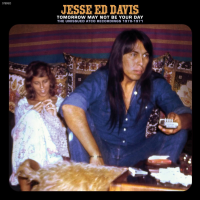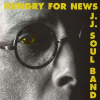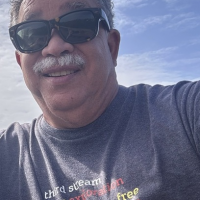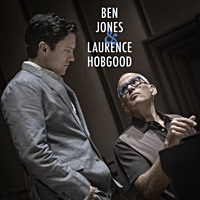Home » Jazz Musicians » Ben Sidran
Ben Sidran
Ben Sidran has been a major force in the modern day history of jazz and rock and roll, having played keyboards with or produced such artists as Van Morrison, Diana Ross, Michael Franks, Rickie Lee Jones, Mose Allison and Steve Miller.
It's been a long and varied journey for Sidran—from playing boogie-woogie piano as a six year old in Racine, Wisconsin, leaning into his jazz records, “literally like an Eskimo huddled around a fire,” to growing up to play boogie-woogie piano around the world. Despite the reality that he is better known in Europe and Japan than in America—a fact of life for most jazz musicians—Ben Sidran is an American success story.
A jazz pianist of international renown, lyricist of a rock classic, award-winning national broadcaster, record and video producer, scholar, author, journalist, and father to a second generation musical prodigy, Sidran makes your average Renaissance man look like a slacker.
Born in Chicago in 1943—his father was a friend of Saul Bellow's—Sidran was raised in the industrial lakeshore city of Racine, Wisconsin, going up to Madison to play keyboards at frat-house parties while still a teenager in 1960. The next year he was enrolled at the university, playing dates on campus and around town. He soon joined the Ardells, a Southern comfort party band led by frat boy singer Steve Miller and his friend Boz Scaggs. But when Miller and Scaggs went west to become stars, Sidran stayed to complete his degree in English lit.
After graduating from the UW in 1967 (with honors), Sidran moved to England to pursue a Master's Degree in American Studies at the University of Sussex. But when the Steve Miller Band came to England the following year to record with the legendary British engineer Glyn Johns, Sidran found himself back on the two-track life of academia and music.
It started with his haunting harpsichord break on Scaggs’ “Baby's Calling Me Home” for the Miller band's debut album, “Children of the Future.” A little later on, Ben would pen the lyrics for Miller's “Space Cowboy,” earning a place in rock history (and enough royalties to pay for his graduate degrees).
While still pursuing his studies, Sidran also developed a relationship with Johns, often doing session work at Olympic Studios with musicians like Eric Clapton and the Rolling Stones. In 1969, Johns produced Sidran's demo tape, featuring Charlie Watts, Peter Frampton and others.
Upon receiving his doctorate in American Studies at the height of the war-induced grad school glut, Sidran faced bleak prospects in academia. Then he realized his time for studying the information was over; it was time to become the information. So in the fall of 1970, after dropping his dissertation with some publishers in New York, he moved to Los Angeles to go into the record business.
Read moreTags
Ben Sidran at 82: Still auditioning for the role of myself

by Leo Sidran
Every year on his birthday, my dad Ben Sidran and I sit down for a conversation. It started when he turned 76, and we've done it ever since--capturing an ongoing record of where his head and heart are at that particular moment. Over the years we've talked about music, memory, politics, travel, the craft of performing, and the art of living. These annual conversations have become a kind of time-lapse portrait: the same two people returning to the ...
Continue ReadingJesse Ed Davis: Tomorrow May Not Be Your Day: The Unissued Atco Recordings 1970-1971

by Doug Collette
Originally reissued in November 2024 as a limited-edition vinyl set, the seventy-four-some minutes of The Unissued Atco Recordings 1970-1971 derives from sessions for Jesse Ed Davis' debut LP Jesse Davis (Atco Records,1971) and its followup of a year later, Ululu (Atco Records, 1972). One of the most unheralded musicians of his time, Jesse Ed Davis' appearance is nevertheless virtually as recognizable as the tone of his guitar: the shock of black hair over his face brings focus to the close ...
Continue ReadingChop Wood And Carry Water: Ben And Leo Sidran On The Election

by Leo Sidran
When everything you thought you knew turns out to be mistaken, when your compatriots let you down, when your neighborhood is on fire and your friends are drowning, when even Quincy Jones decides he's checking out, it helps to have someone to talk to, to help make sense of it all. For me, it's my dad Ben Sidran. Our talks don't really begin or end, they simply continue. This podcast has given me the chance to document some ...
Continue ReadingBen Sidran: It Don't Mean A Thing If It Ain't Got That Swing State

by Dean Nardi
Beyond Ben Sidran's appreciable talents as an accomplished composer and performer in jazz, blues, ragtime and several other styles, he is also a highly proficient producer (Richie Cole, Phil Upchurch, Lee Konitz, Georgie Fame, Michael Franks, Rickie Lee Jones, Mose Allison), an author, podcaster, radio and television host and a historian. He was part of the early Steve Miller Band with Boz Scaggs and has recorded 35 albums in 50 of the 81 years he has been on the planet. ...
Continue ReadingBen Sidran: If You Can't Laugh At Life You're Through

by Leo Sidran
In a career spanning over fifty years and thirty five records, Ben Sidran has established himself as a philosopher poet. Equally celebrated for his precise, probing writing style as he is for his improvised spoken word jazz raps, he has carved out a truly unique space for himself. The Times of London aptly described Ben as “the world's first existential jazz rapper," and The Chicago Sun Times once referred to him as “a renaissance man cast adrift in the modern ...
Continue ReadingBen Sidran at 80: This is your life

by Leo Sidran
For the fifth consecutive year I interviewed my father, Ben Sidran on his birthday. This year he's turning 80 and I surprised him with reflections and anecdotes by friends and colleagues from throughout his career, including Jeff Greenfield, Boz Scaggs, Jann Wenner, Glyn Johns, Michael Cuscuna, Phil Upchurch, Georgie Fame, Gil Goldstein, Neil Tesser, Janis Siegel, Jorge Drexler and many more! ...
Continue ReadingBen Sidran At 79: Simplicity Will Get You In The End

by Leo Sidran
For the fourth year in a row, I talked to my dad, musician/producer/journalist/philosopher Ben Sidran in honor of his birthday. This time he's turning 79 and we consider the sociological implications of mowing the lawn, Donald Fagen's solo recordings, the significance of the 1960s in popular culture today, Pharoah Sanders album Pharoah's First (ESP), interviews he conducted in the 1980s with Miles Davis and Sonny Rollins, the myth of Sisyphus, his most recent album Swing State (Nardis), and his idea ...
Continue ReadingBen Sidran's First All-Instrumental Album, 'Swing State,' Set For Sept 16 Release On Nardis Records, Distributed By Bonsai

Source:
Terri Hinte Publicity
Sixty years into a wildly accomplished career that counts music as only the foremost of many aspects, Ben Sidran takes yet another new direction with the September 16 release of Swing State (Bonsai/Nardis). Long known for his lively, bluesy singing style (in the vein of his mentor Mose Allison), the 78-year-old finally gives his vocal cords a rest with an all-instrumental jazz album with Leo Sidran, his son, on drums and Billy Peterson, a co-conspirator of nearly five decades, on ...
read more
Don Cherry Interview - Talking Jazz with Ben Sidran / Remixed & Reproduced on Soulandjazz.com

Source:
J. Scott Fugate
Soulandjazz.com Presents: Talking Jazz with Ben Sidran Episode 3: Don Cherry Musical Selection & Additional Production by J. Scott Fugate Here's the story: Back in the mid-80's on National Public Radio (NPR) in America, a show ran called Sidran On Record. Presented by Ben Sidran, a musician, author, lecturer and journalist, the show featured interviews with the great and the good from the world of Jazz. Miles, Dizzy, Herbie and Grover were amongst 60 interviews that ...
read more
Jazz This Week: Christian McBride and Peter Martin, Hamiet Bluiett, the Cunninghams, Garage a Trois, Ben Sidran, and More

Source:
St. Louis Jazz Notes by Dean Minderman
The fall presenting season of jazz and creative music in St. Louis gets off to a fast start this week, with season openers from three different concert series; homecoming visits from some St. Louis natives; and two local musicians with international reputations playing on local stages. Let's go to the highlights: Tonight, Cabaret St. Louis opens its season with actress and singer Linda Purl's show “Come Rain or Come Shine," which runs through Saturday at the Kranzberg Arts Center. Then ...
read more
Ben Sidran to Perform Sunday, September 12 at Kol Am Temple

Source:
St. Louis Jazz Notes by Dean Minderman
Keyboard player, singer, composer, author and broadcaster Ben Sidran (pictured) is coming to St. Louis for a performance at 6:00 p.m. Sunday, September 12 at Kol Am Temple, 1023 Chesterfield Parkway. KWMU's Dennis Owsley will serve as host as Sidran performs and shares “his insights on Jews, Music, and the American Dream." Sidran first gained fame working with the Steve Miller Band, and has gone on to perform and record with musicians and signers including Eric Clapton, the Rolling Stones, ...
read more
Ben Sidran to Release "Dylan Different"

Source:
Michael Ricci
Dylan Different is an unusual sort of Bob Dylan tribute album. Jazz icon Ben Sidran adds his musical style and a lifetime of reflection to 12 of Dylan's most memorable songs ("Highway 61 Revisited," “Tangled up in Blue" and “Blowin' in the Wind" among them).
Dylan Different was recorded in an Alsatian farm house with French musician/singer Rodolph Burger as well as Italian bassist Marcello Gioullianai and Alberto Malo, a Spanish drummer currently living in Switzerland. The European aspect of ...
read more
"a Renaissance man cast adrift in the modern world" — the Chicago Sun Times "The first existential jazz rapper" — the London Times





![Ben There, Done That [Live Around The World] by Ben Sidran](https://s3.amazonaws.com/allaboutjazz/coverart/large/69bb6d981e01978b788d194ecfcd8552.jpg)
































